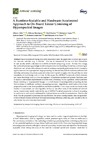Identificador persistente para citar o vincular este elemento:
https://accedacris.ulpgc.es/jspui/handle/10553/54963
| Título: | A runtime-scalable and hardware-accelerated approach to on-board linear unmixing of hyperspectral images | Autores/as: | Ortiz, Alberto Guerra Hernández, Raúl Celestino Lopez, Sebastian Otero, Andrés Sarmiento Rodríguez, Roberto de la Torre, Eduardo Rodríguez, Alfonso |
Clasificación UNESCO: | 3307 Tecnología electrónica | Palabras clave: | Parallel Implementation Fast Algorithm Classification Capabilities Compression, et al. |
Fecha de publicación: | 2018 | Proyectos: | Plataforma Hw/Sw Distribuida Para El Procesamiento Inteligente de Información Sensorial Heterogenea en Aplicaciones de Supervisión de Grandes Espacios Naturales TEC2017-86722-C4-2-R PLATAFORMA HW/SW DISTRIBUIDA PARA EL PROCESAMIENTO INTELIGENTE DE INFORMACION SENSORIAL HETEROGENEA EN APLICACIONES DE SUPERVISION DE GRANDES ESPACIOS NATURALES |
Publicación seriada: | Remote Sensing | Resumen: | Space missions are facing disruptive innovation since the appearance of small, lightweight, and low-cost satellites (e.g., CubeSats). The use of commercial devices and their limitations in cost usually entail a decrease in available on-board computing power. To face this change, the on-board processing paradigm is advancing towards the clustering of satellites, and moving to distributed and collaborative schemes in order to maintain acceptable performance levels in complex applications such as hyperspectral image processing. In this scenario, hybrid hardware/software and reconfigurable computing have appeared as key enabling technologies, even though they increase complexity in both design and run time. In this paper, the ARTICo(3) framework, which abstracts and eases the design and run-time management of hardware-accelerated systems, has been used to deploy a networked implementation of the Fast UNmixing (FUN) algorithm, which performs linear unmixing of hyperspectral images in a small cluster of reconfigurable computing devices that emulates a distributed on-board processing scenario. Algorithmic modifications have been proposed to enable data-level parallelism and foster scalability in two ways: on the one hand, in the number of accelerators per reconfigurable device; on the other hand, in the number of network nodes. Experimental results motivate the use of ARTICo(3)-enabled systems for on-board processing in applications traditionally addressed by high-performance on-Earth computation. Results also show that the proposed implementation may be better, for certain configurations, than an equivalent software-based solution in both performance and energy efficiency, achieving great scalability that is only limited by communication bandwidth. | URI: | https://accedacris.ulpgc.es/handle/10553/54963 | ISSN: | 2072-4292 | DOI: | 10.3390/rs10111790 | Fuente: | Remote Sensing [ISSN 2072-4292], v. 10(11), 1790 |
| Colección: | Artículos |
Citas SCOPUSTM
3
actualizado el 08-jun-2025
Citas de WEB OF SCIENCETM
Citations
3
actualizado el 08-jun-2025
Visitas
81
actualizado el 02-mar-2024
Descargas
69
actualizado el 02-mar-2024
Google ScholarTM
Verifica
Altmetric
Comparte
Exporta metadatos
Los elementos en ULPGC accedaCRIS están protegidos por derechos de autor con todos los derechos reservados, a menos que se indique lo contrario.
